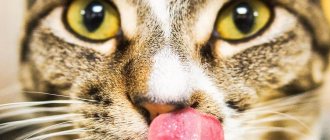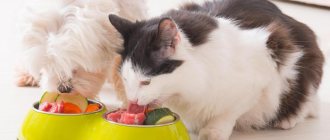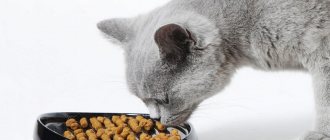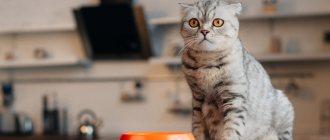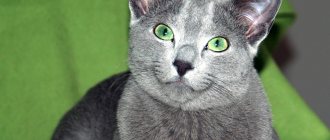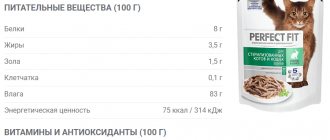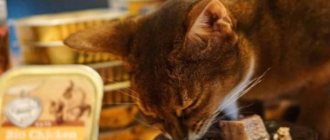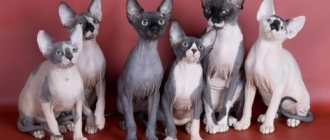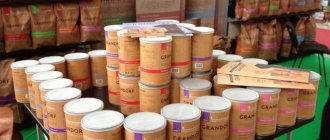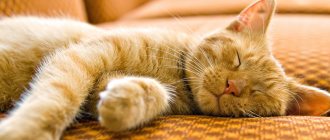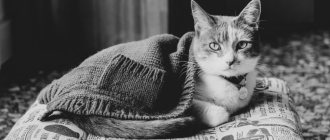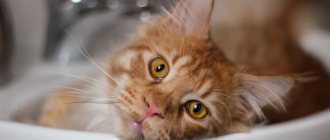Feeding cats with natural food is as close as possible to the conditions of the wild. Despite this, such a diet has its disadvantages and nuances. Before feeding your animal regular foods, be sure to familiarize yourself with possible problems and features. This will help you weigh the pros and cons between dry food and natural food.
Why owners choose natural feeding
Most owners refuse dry food, choosing a more natural way of feeding. Citing the advantages of a “straight woman” as an example, they often forget about her shortcomings.
Advantages
The main advantage is the ability to independently control the quality of ingredients. This eliminates the presence of harmful chemicals and artificial components.
With this type of nutrition, it is easier to choose an individual diet, based on the characteristics and preferences of your pet. It is much easier to accustom to “natural” than to “drying”. Cats are carnivores, so they happily eat meat and offal.
Possible disadvantages
Natural food for cats should always be fresh, which means it will have to be prepared every day. This takes a lot of time and effort, so not all owners are ready for such sacrifices.
In addition to the laboriousness of preparation, it is worth noting the difficulty of achieving a balance of KBJU (calories, proteins, fats and carbohydrates) and the mandatory inclusion of vitamin and mineral supplements. There is also a high probability of helminth infection or poisoning associated with improper storage or preparation of products.
How to switch an animal to natural food
It’s good when a kitten is accustomed to natural products from childhood, but it is quite possible to retrain a cat that is accustomed to dry food. If you change food suddenly, the animal may become stubborn, refuse to eat and go hungry for several days. To make the transition painless, you will have to try a little.
Natural food should be mixed in a small amount into the daily portion of dry food, replacing approximately 10% at first. Gradually, the share of natural food should be increased, and dry food should be reduced. After two weeks, you can completely switch to natural nutrition.
Main components of the diet
A natural diet for cats consists of proteins, fats and carbohydrates. Their percentage ratio should ideally be 52:36:12.
Proteins: meat and dairy products
Proteins are used in the construction of new cells and act as the main source of energy. All of them are divided into 2 large groups:
- Animals
. Contained in meat (chicken, turkey, beef, rabbit, lamb), offal (liver, lung, heart), fish, eggs and fermented milk products (cottage cheese, kefir, yogurt). Chicken protein is the easiest to digest, and the worst is beef and lamb protein. Such proteins contain many amino acids and taurine, an essential element responsible for cell protection and regeneration.
- Vegetable
. Contained in soybean meal, corn gluten and wheat. They are less digestible than animal proteins and put a strain on the kidneys, which leads to alkalinization of the urine. Can be used in small quantities as a temporary alternative to more expensive animal proteins.
When feeding, it is necessary to use well-frozen raw and boiled meat or sea fish, cleaned of bones. Fish can be given no more than 1-2 times a week, since the thiaminase it contains destroys vitamin B. Eggs should be given according to the same scheme.
Fermented milk products cannot serve as the main dish, so they are used as an additive.
Where are fats found?
Fats are responsible for energy “in reserve.” They are also responsible for the absorption of fat-soluble vitamins and the synthesis of certain hormones. The most beneficial fatty acid is Omega-6, found in fish. This element can also be obtained from corn, pumpkin or flaxseed.
Remember to maintain balance. A lack of fat can affect the quality of skin and coat, and an excess can lead to pancreatitis and intestinal upset.
Carbohydrates: cereals and vegetables
Carbohydrates make up the smallest portion of a cat's natural diet, as they take much more time and effort to digest. In the wild, these elements enter the cat's stomach in a semi-digested form through a captured rodent.
Despite this, a small amount of carbohydrates is simply necessary for mustachioed pets. Of these, the following elements enter the body:
- fiber, which normalizes stool and facilitates hair removal;
- adhesive substance that prevents constipation;
- glucose, which supports the functioning of the kidneys, brain and other vital organs;
- prebiotics that normalize intestinal microflora and facilitate the absorption of food.
Carbohydrates come from raw, boiled or steamed vegetables (broccoli, zucchini, pumpkin) and fruits (apples). Complex carbohydrates include oatmeal, buckwheat, rice and egg.
Vitamins and microelements
Unlike “drying”, “natural” for cats should be supplemented with vitamin and mineral complexes. The most important elements include:
- manganese;
- iodine;
- calcium;
- potassium;
- iron;
- taurine;
- phosphorus;
- potassium;
- omega 3 and 6;
- B vitamins and ascorbic acid.
It is better to discuss the choice of drug with your veterinarian, since the dosage is calculated individually. Additionally, you can add sprouted oats and brewer's yeast to your food.
A lack of vitamins is accompanied by deterioration in coat quality, loss of body weight, loss of activity and frequent colds. Excess is no less dangerous, so never buy drugs on the advice of friends.
Cat food classes
Cat food is represented by the following classes:
- Economy - based on soy protein, cereals, animal by-products. Differences in taste are achieved by flavorings. The composition may contain dyes, flavoring additives, and preservatives.
- Commercial (middle class) - based on higher quality by-products than economy class. The composition does not contain preservatives or dyes. In addition to a wide range of flavors, the food is different in purpose: for sterilized cats, for cats suffering from diseases of the excretory system and gastrointestinal tract.
- Premium is based on natural products with a minimum of grains and no flavoring additives. Premium cat food does not contain by-products, but real meat. They are usually enriched with mineral complexes. Presented in various lines by age, in therapeutic and dietary series. Even the shape of their granules is selected to be most convenient for the animal’s jaw apparatus.
- Super-premium (holistic) - the composition of this food is made in accordance with the natural diet. Made from natural products certified as suitable for human consumption: fresh raw meat, vegetables, a complex of microelements. Most often found frozen. The food provides balanced digestion.
What foods should not be given to a cat?
Before feeding your cat natural food, read the list of prohibited foods. These include:
- millet, pearl barley, semolina and corn cereals;
- river fish and any bones;
- potatoes and mushrooms;
- legumes and white cabbage;
- onions, sorrel and garlic;
- pork and lard;
- grapes and raisins.
Milk is only beneficial for kittens, since the body of adult animals does not digest lactose. It is also worth excluding any handouts from the table: flour, spices, pickles, smoked foods, sweets, fatty and fried foods.
Calculation of the daily portion of natural drinks
On average, the daily portion for an adult cat is 5% of body weight. For simplicity, you can limit yourself to this indicator, but it is more reliable to take into account the characteristics of your pet and calculate not the number of grams, but the total calorie content.
For this purpose, it is recommended to use the following formula:
K*(30*m + 70), where K is the multiplier coefficient, and m is the weight of the animal.
The coefficient values can be found in the table below.
| Physiological features | K |
| Lactation period | 2-4 |
| Pregnancy | 1,6-2 |
| Adult and active animal | 1,6 |
| Adult animal with low activity | 1,4 |
| Kitten or adult animal with low weight | 1,2-1,4 |
| Presence of castration or sterilization | 1,2 |
| Elderly age | 1,1 |
| Frequent overeating, fraught with rapid obesity | 1 |
| Physician-confirmed obesity | 0,8 |
If your cat is carrying kittens and weighs 4.5 kg, then she will need 328-410 kcal per day. To get the serving size, the indicated number of calories must be divided by 2, since adults eat twice a day.
Important Rules
Feeding your cat natural products should be safe. Be careful when purchasing meat to avoid the presence of hormones and parasites.
Maintain regular feedings. This will help wean you off begging and eliminate prolonged feelings of hunger. Kittens up to 3 months are fed at least 6 times a day, gradually reducing the frequency to 2 times a day by 1 year.
Serve food in the same area and be sure to use different bowls if you have multiple pets. This will eliminate fights with subsequent overeating in the strongest pet. Remember that food should be at room temperature, and leftovers should be thrown away or refrigerated for several hours.
Rules for organizing wet food feeding
A good wet hypoallergenic cat food or dietary treat is not suitable for all pets, and when choosing such food it is important to consider the following factors:
- after opening a canned food or package, they cannot be stored for a long time;
- feeding with wet food must be combined with the correct drinking regime;
- Wet food is more expensive than dry food and the food supply should not exceed reasonable limits.
When purchasing food for future use, cat owners should understand that when the expiration date expires, all canned food will have to be thrown away.
Approximate diet for 4 days
Before going to the store, think through your diet for the week ahead, based on the permitted products. For an example, check out the menu for an adult pet for 4 days.
| Day | 1st meal | 2nd meal |
| First | Cottage cheese with raw quail egg | Boiled cod with vegetables |
| Second | Minced chicken with vegetables, seasoned with vegetable oil | Chicken fillet with buckwheat and carrots |
| Third | Boiled beef with zucchini | Boiled chicken liver with oatmeal and herbs |
| Fourth | Broccoli puree with cottage cheese, seasoned with kefir and vegetable oil. | Chicken hearts with cottage cheese |
When selecting a menu, do not forget to take into account the KBZHU in order to eliminate the shortage of necessary elements. Pay special attention to animals with special needs.
Types of feed
On the shelves we find a large assortment of ready-made cat food. It is customary to classify it:
- Canned - produced in sealed jars. They contain natural ingredients and enough moisture to provide the cat with the necessary substances. After opening the can, the food should be consumed immediately. If there is any left, store in a glass container in the refrigerator.
- Wet (liquid) – available in portioned patches. It is made primarily from soy protein. The pieces are soaked in gravy, which gives a moisture content of about 35%. An open pack should be stored in a cool place.
- Dry – available in plastic bags. The food in the bowl can stand until the cat finishes it; The main thing is that there is always water nearby for drinking. High-quality food will provide a full range of nutrients. A plus is brushing your teeth while biting into the croquettes.
Feeding cats with special needs
A separate category includes pets, marked in the table with the calculation of the coefficient for determining the daily calorie content. In addition to the number of calories, when planning their menu you will have to take into account several more important nuances.
Pregnant and lactating females
During pregnancy and lactation, females provide food not only for themselves, but also for their kittens. For this reason, during these periods, calorie content is increased by 1.5-2 times. Due to changes in the amount of food, the feeding frequency is increased to 5-6 times. This makes it easier to digest.
The pet should be fed with chicken egg whites and vegetable oil should be added to its food. This will help avoid too much protein consumption during lactation and prevent constipation.
Kittens
For the first 4-8 weeks, kittens need enough mother's milk. After this time, you can introduce the first complementary foods, consisting of:
- meat broth and minced meat;
- vegetable puree;
- boiled yolk;
- slimy rice porridge and semolina;
- low-fat cottage cheese, kefir and yogurt.
Unlike adults, most of a kitten's food should consist of carbohydrates. For bone growth, make sure you have enough calcium.
Elderly individuals
With age, metabolic processes slow down. An older cat needs much less food than a young cat. Additionally, dental problems develop. During this period, you should use soft and easily digestible foods, increasing the number of meals to reduce the load on the stomach.
Allergy sufferers
If you suspect an allergy, you need to find the allergen. To do this, use an elimination diet, which involves the gradual elimination of staple foods. First of all, it is recommended to remove chicken and egg whites, as they often cause allergic reactions.
With chronic diseases
For chronic urolithiasis, it is recommended to reduce proteins, abandoning plant-based ones in favor of animal ones. Chicken, turkey and rabbit put much less strain on the kidneys and liver, so they are more preferable.
Another useful recommendation for sick pets is split meals. Frequent, but small portions reduce the load on the damaged organ and facilitate the digestion process. It is better to find out the exact menu from your veterinarian, as it is always selected individually.
Spayed and neutered animals
Sterilization and castration slow down metabolism, causing a tendency towards obesity. After surgery, you need to use more fiber to create a feeling of fullness with a small amount of calories. You should also avoid fish in any form, since removal of the reproductive organs increases the risk of developing urolithiasis.
Underweight or overweight
If you are underweight, it is forbidden to rely on fats, since a weakened liver will not be able to cope with such a load. To gain weight, it is necessary to use high-calorie dishes in order to increase the number of calories per day without violating the BJU norm. Proteins should remain the basis of the diet. In this case, the cat will gain weight from muscle, not fat.
Overweight must be dealt with in the same way. Don't try to cut fat or carbs, just cut your total calories. Reduce portions gradually so as not to cause stress.
In both situations, feeding should be frequent. Small portions are easier for the stomach to digest, and the absence of long breaks between meals eliminates starvation.
The best cat foods in the category: super premium
A food of this level is not so far removed from holistic in composition, but still contains natural preservatives and a little more ingredients of plant origin. This food is absolutely safe for cats if it is chosen correctly depending on the needs of the animal. As in the holistic category, there are also veterinary foods that are suitable for cats with illnesses or after operations. The cost of super-premium products is quite high.
Hills Science Diet (Prescription Diet)
Photo: www.petco.com
Average price in the Russian Federation : from 900 rubles. for 1.5 kg
Why in the rating : the brand has a wide selection of food varieties aimed at very specific requirements: anti-obesity, heart and kidney health, for allergy sufferers, post-operative feeding, and so on. Finding food on sale is not difficult if you go to a veterinary pharmacy, but you can also find it in regular pet stores.
Disadvantages : Hills has been produced in Russia for a long time, which causes felinologists to worry about the quality of the products. When buying this food, you should pay attention to the country of origin - pay attention to European factories.
Rating : 8.8 out of 10
From reviews of Hills Science Diet : “An excellent solution for a diet after surgery, but for the right choice it is better to consult a veterinarian.”
Eukanuba
Photo: www.petzilla.co.uk
Average price in the Russian Federation : from 1200 rubles. for 2 kg
Why in the rating : the company has both a veterinary and a daily series, and both belong to the super-premium class - and this does not happen so often. The food has a very well-balanced composition with a maximum of meat ingredients, and the daily portion of food will be quite small due to its nutritional value.
Disadvantages : the food contains vegetable protein. In addition to the fact that the assortment cannot be called very wide, it may not be available in most pet stores.
Rating : 8.5 out of 10
From reviews of Eukanuba : “When choosing the type of food, you should consider how well the cat tolerates plant protein.”
1st Choice
Photo: www.cty-fish.com
Average price in the Russian Federation : from 1200 rubles. for 2.27 kg
Why in the rating : the food is produced in Canada, which means it undergoes a very strict quality assessment. Proteins and carbohydrates are perfectly balanced in the composition, but there is also a completely safe hypoallergenic food option.
Disadvantages : the choice of food types is not very large. In addition, the composition contains a couple of undesirable ingredients: cellulose and so-called “poultry meal”. The problem with the last component is that it is impossible to determine what such flour consists of - you can only hope for the integrity of the manufacturer.
Rating : 8 out of 10
From reviews of 1st Choice : “Very small portions are enough for a cat to be satisfied.”
The best cat foods in the category: premium
Affordable, high-quality premium food can now be purchased at most pet stores, both in bags and in bulk. The composition of this food is quite decent, natural preservatives are used, but the amount of corn can be too large. However, premium food is a fairly good daily nutrition for a healthy animal. The lines also include offers for kittens, sterilized cats and aging cats.
Hills Science Plan
Photo: images.vet-medic.com
Average price in the Russian Federation : from 790 rubles. for 2 kg
Why in the rating : the range of food is very wide and there is an option for even the most picky cat. The composition is very carefully selected and balanced, and you can choose meals with different amounts of protein. There is also food for dental health, which is very important to monitor throughout the cat’s life.
Disadvantages : there is a risk of buying a batch produced at a Russian plant - the standards are completely different here. Contains vegetable protein and grains.
Rating : 7.9 out of 10
From reviews of Hills Science Plan : “It is important to choose nutrition based on the age of the animal.”
Royal Canin
Photo: static.shop033.com
Average price in the Russian Federation : from 650 rubles. for 2 kg
Why in the rating : food is available in almost every pet store, at a price slightly higher than economy class, and the composition is much more balanced and nutritious. The choice of food types is very large, and the specialized veterinary series even belongs to the super-premium class. There is food for dental health - it is not so often found in the lines of well-known companies.
Disadvantages : there has been a plant in Russia for a long time, and felinologists, as already mentioned, prefer European or American production. Contains ingredients of plant origin.
Rating : 7.5 out of 10
From reviews of Royal Canin : “The series for kittens and older cats are especially good.”
Purina ProPlan
Photo: nt.petplanet.co.uk
Average price in the Russian Federation : from 650 rubles. for 1.5 kg
Why in the rating : the composition of the food is perfectly balanced and does not require any dietary supplements; in addition, it contains the probiotics and enzymes that cats need. The price is very affordable and there is a fairly large assortment on sale everywhere.
Disadvantages : it contains a lot of herbal ingredients, liver (cats are allergic to it), animal fat of unknown origin.
Rating : 7 out of 10
From reviews of Purina ProPlan : “Under no circumstances should it be mixed with natural food, otherwise it will end in allergies.”
Possible problems
Feeding cats natural food does not always go as planned. Most often, problems arise when switching to “natural” from “drying”.
Food allergies
Allergies to foods happen not only to people, but also to their mustachioed pets. If alarming symptoms are detected, it is necessary to identify the allergen product and permanently exclude it from the menu.
Refusal of meat
If the cat happily eats all the other ingredients, then it is worth showing him to the veterinarian. There is a high probability of having digestive problems. In the opposite situation, the cause of failure may be a change in power supply. If your pet has been eating dry food all the time, then give him time to get used to new dishes.
The cat does not eat enough or overeats
Raw meat takes a long time to digest, leaving you feeling full for a long time. If the pet does not eat enough, feed it strictly raw meat dishes. Don't forget to make sure he gets enough fiber. She also fights hunger well.
Frequent overeating is fraught with obesity and the resulting pathologies. If your cat has a rounded belly and a sagging tummy, cut down on his calories and single servings, not forgetting to increase the number of feedings to 5-6 times instead of the standard 2.
What not to feed cats
Cats eat food from the human table with enviable pleasure, and many owners watch with emotion as the animal happily treats itself to candy or a piece of chocolate, licks ice cream or eats a slice of melon, peach, tomato, sausage, or cheese.
Of course, a one-time consumption of a small amount of products that are exotic for the cat’s body is unlikely to lead to a serious illness, but you cannot constantly give such products to an animal: this can cause a chronic disease and significantly reduce the pet’s life expectancy.
The following foods should not be included in cat food:
- Fresh milk - this leads to impaired intestinal motility and indigestion.
- Food from the table - salt and seasonings contained in human food can even cause poisoning. And sausage, for example, contains soy products and a lot of fats, which are harmful to the cat's health.
- Sweets - carbohydrates are harmful to cats, since sugar is not processed at all by the digestive system.
- Coffee and alcohol are poisons for animals.
- Raw unprocessed meat and river fish - it is better to give the meat boiled or at least pour boiling water over it, since there is a high possibility of infection with helminths. River fish can be present in a cat's food only in boiled form, with selected bones.
- Pork – contains too much fat that the animal’s stomach may not be able to handle.
- Tubular or sharp bones - damage to the esophagus or stomach will definitely lead to the death of the pet.
Eating such products by an animal will inevitably lead to illness and deterioration in health.
Veterinarian advice
There are several tips that experienced veterinarians give to cat owners who want to feed their pets natural products:
- You cannot feed fermented milk and meat products to an animal at the same feeding. Fermented milk products are given at one meal, and meat at another.
- Fermented milk products can be given separately or mixed together; only bran or half a raw egg can be added to them.
- Meat feeding is either meat, fish, or offal. You should not mix foods in one feeding.
The cat should always have a bowl of clean, fresh water: the animal should be able to replenish the lack of moisture in the body when it needs it.
Flour foods and diabetes
If an animal has a disease such as diabetes, then flour food is strictly contraindicated for it. A carbohydrate-free diet is indicated for feeding animals with this disease.
Eating food high in carbohydrates will aggravate the disease and may lead to the death of the animal.
Attention! Cats are not recommended to eat food containing large amounts of carbohydrates.
Drinking regime
Drinking water should be bottled or filtered. This eliminates the presence of salts. Renew the water daily and make sure it is always in the bowl.
To be safe, place several containers around the house. Sometimes cats are too lazy to get to the kitchen. For this reason, they may not reach their daily requirement.
Most nutritional recommendations are based on living conditions in the wild. Unlike stray cats, domestic cats rarely catch birds and mice, do not fight for territory and prefer a sofa lifestyle. Low activity and individual characteristics impose many restrictions that exclude similarity with average indicators. For this reason, it is better to discuss your pet’s menu with your veterinarian.
Do you like the article? 245
What is important to consider when choosing ready-made wet food
To choose the best wet cat food, you need to rely on the information and recommendations provided on the packaging.
To make the right choice, it is better to first consult with an experienced veterinarian who will examine the animal and help develop an optimal diet.